THE British SYSTEM OF EDUCATION The UK has

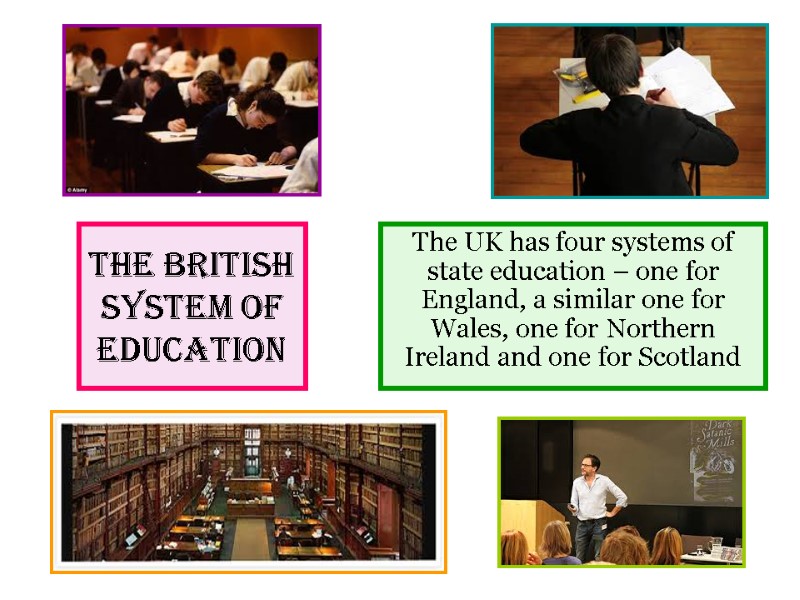
THE British SYSTEM OF EDUCATION The UK has four systems of state education – one for England, a similar one for Wales, one for Northern Ireland and one for Scotland

GENERAL CHARACTERISTICS Cultural differences have influenced the organization, attitudes, standards and values of these national systems though they share the following characteristics: State education is provided and controlled by central government and local authorities in partnership Public authorities and voluntary organizations work together as partners State education is freely available to all, regardless of sex, colour, social class, religion or politics Education is planned to give children equal but varied opportunities Responsibility for school organization and teaching methods is exercised mainly by teachers, rather than by school inspectors or other government agents Many agencies such as public libraries, museums, art galleries, and the educational liaison staff of large companies cooperate with the schools
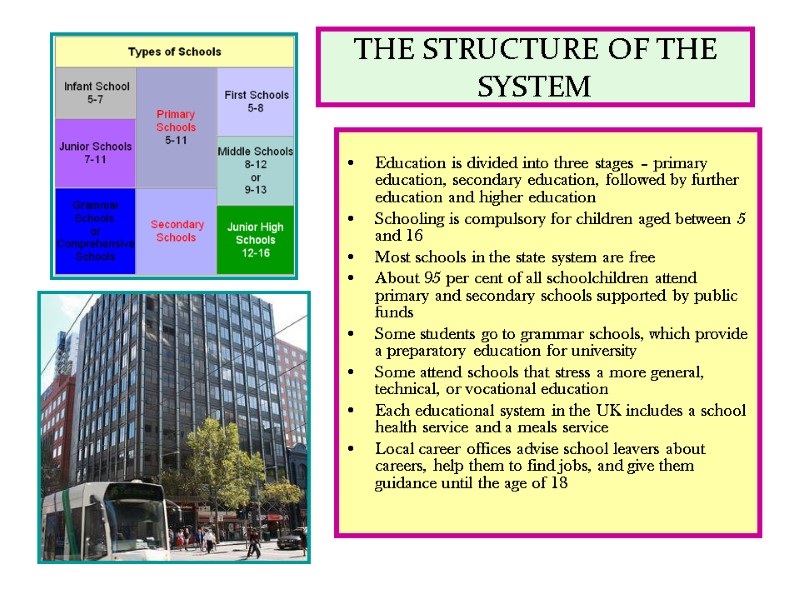
THE STRUCTURE OF THE SYSTEM Education is divided into three stages – primary education, secondary education, followed by further education and higher education Schooling is compulsory for children aged between 5 and 16 Most schools in the state system are free About 95 per cent of all schoolchildren attend primary and secondary schools supported by public funds Some students go to grammar schools, which provide a preparatory education for university Some attend schools that stress a more general, technical, or vocational education Each educational system in the UK includes a school health service and a meals service Local career offices advise school leavers about careers, help them to find jobs, and give them guidance until the age of 18
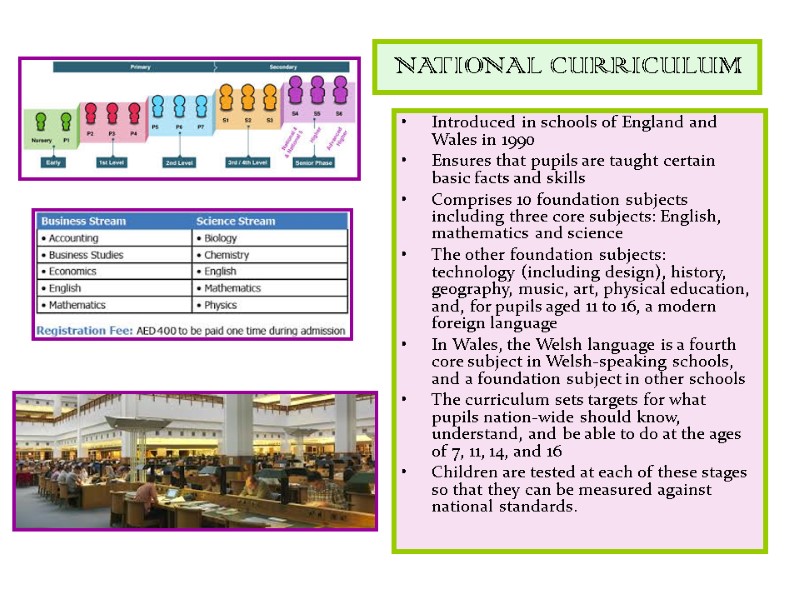
NATIONAL CURRICULUM Introduced in schools of England and Wales in 1990 Ensures that pupils are taught certain basic facts and skills Comprises 10 foundation subjects including three core subjects: English, mathematics and science The other foundation subjects: technology (including design), history, geography, music, art, physical education, and, for pupils aged 11 to 16, a modern foreign language In Wales, the Welsh language is a fourth core subject in Welsh-speaking schools, and a foundation subject in other schools The curriculum sets targets for what pupils nation-wide should know, understand, and be able to do at the ages of 7, 11, 14, and 16 Children are tested at each of these stages so that they can be measured against national standards.
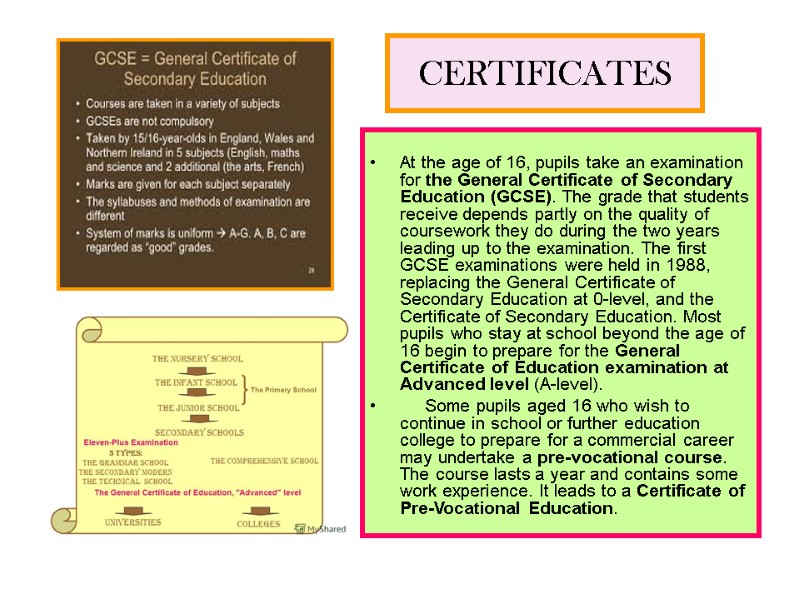
CERTIFICATES At the age of 16, pupils take an examination for the General Certificate of Secondary Education (GCSE). The grade that students receive depends partly on the quality of coursework they do during the two years leading up to the examination. The first GCSE examinations were held in 1988, replacing the General Certificate of Secondary Education at 0-level, and the Certificate of Secondary Education. Most pupils who stay at school beyond the age of 16 begin to prepare for the General Certificate of Education examination at Advanced level (A-level). Some pupils aged 16 who wish to continue in school or further education college to prepare for a commercial career may undertake a pre-vocational course. The course lasts a year and contains some work experience. It leads to a Certificate of Pre-Vocational Education.
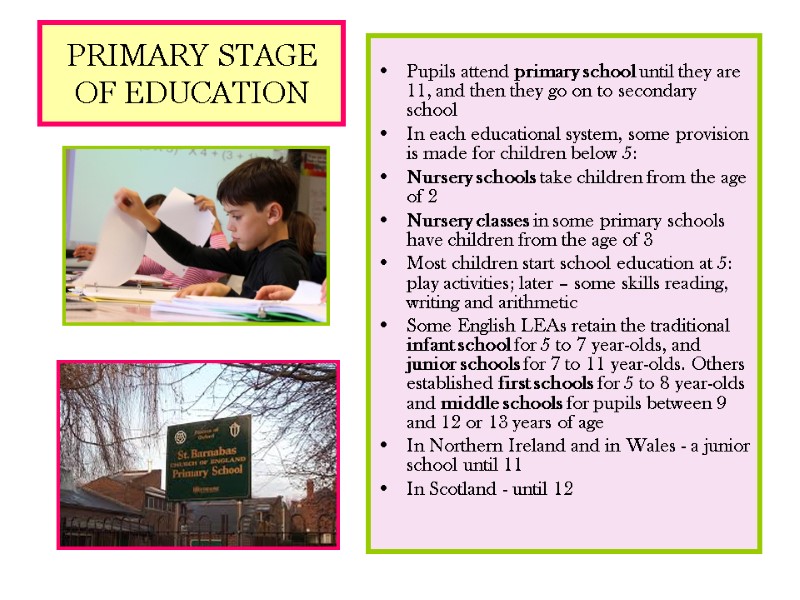
PRIMARY STAGE OF EDUCATION Pupils attend primary school until they are 11, and then they go on to secondary school In each educational system, some provision is made for children below 5: Nursery schools take children from the age of 2 Nursery classes in some primary schools have children from the age of 3 Most children start school education at 5: play activities; later – some skills reading, writing and arithmetic Some English LEAs retain the traditional infant school for 5 to 7 year-olds, and junior schools for 7 to 11 year-olds. Others established first schools for 5 to 8 year-olds and middle schools for pupils between 9 and 12 or 13 years of age In Northern Ireland and in Wales - a junior school until 11 In Scotland - until 12
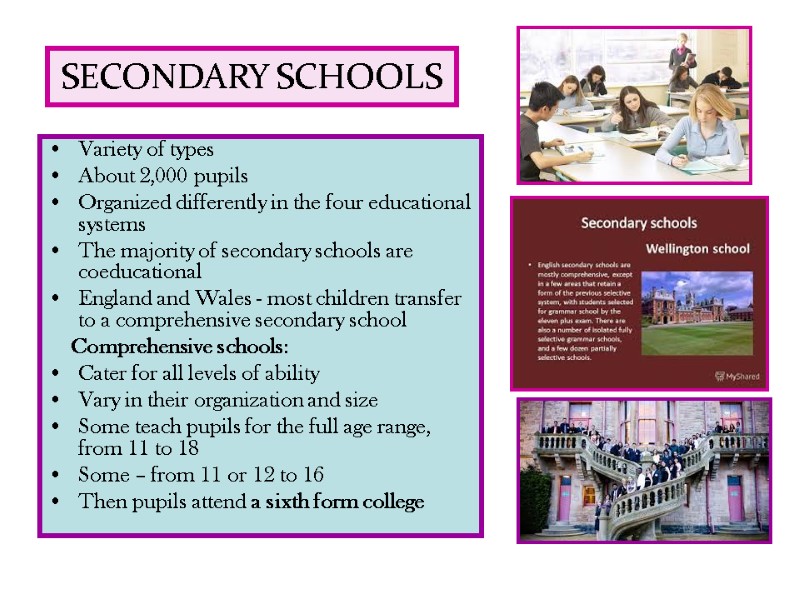
SECONDARY SCHOOLS Variety of types About 2,000 pupils Organized differently in the four educational systems The majority of secondary schools are coeducational England and Wales - most children transfer to a comprehensive secondary school Comprehensive schools: Cater for all levels of ability Vary in their organization and size Some teach pupils for the full age range, from 11 to 18 Some – from 11 or 12 to 16 Then pupils attend a sixth form college
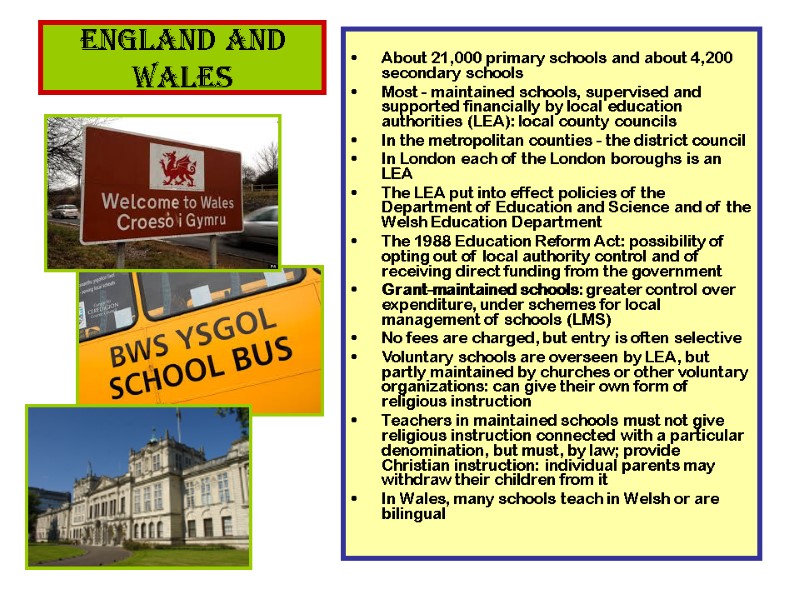
ENGLAND AND WALES About 21,000 primary schools and about 4,200 secondary schools Most - maintained schools, supervised and supported financially by local education authorities (LEA): local county councils In the metropolitan counties - the district council In London each of the London boroughs is an LEA The LEA put into effect policies of the Department of Education and Science and of the Welsh Education Department The 1988 Education Reform Act: possibility of opting out of local authority control and of receiving direct funding from the government Grant-maintained schools: greater control over expenditure, under schemes for local management of schools (LMS) No fees are charged, but entry is often selective Voluntary schools are overseen by LEA, but partly maintained by churches or other voluntary organizations: can give their own form of religious instruction Teachers in maintained schools must not give religious instruction connected with a particular denomination, but must, by law; provide Christian instruction: individual parents may withdraw their children from it In Wales, many schools teach in Welsh or are bilingual
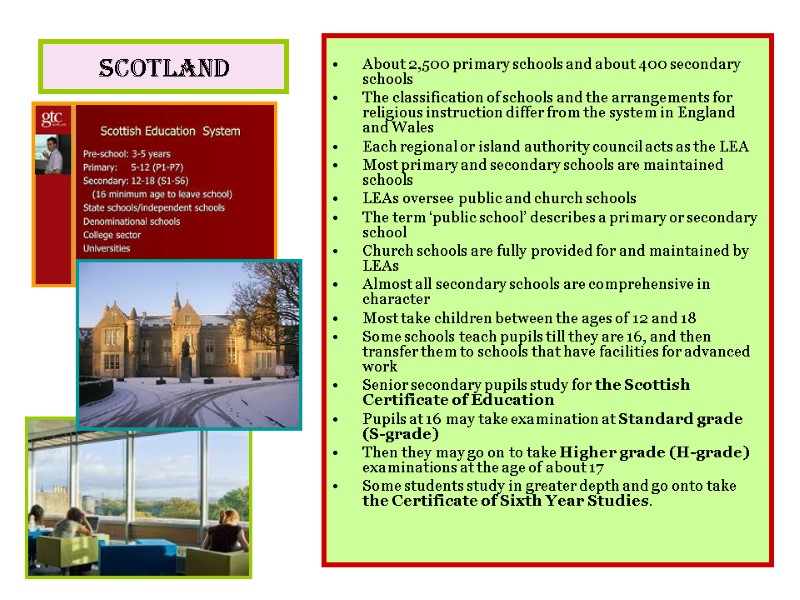
SCOTLAND About 2,500 primary schools and about 400 secondary schools The classification of schools and the arrangements for religious instruction differ from the system in England and Wales Each regional or island authority council acts as the LEA Most primary and secondary schools are maintained schools LEAs oversee public and church schools The term ‘public school’ describes a primary or secondary school Church schools are fully provided for and maintained by LEAs Almost all secondary schools are comprehensive in character Most take children between the ages of 12 and 18 Some schools teach pupils till they are 16, and then transfer them to schools that have facilities for advanced work Senior secondary pupils study for the Scottish Certificate of Education Pupils at 16 may take examination at Standard grade (S-grade) Then they may go on to take Higher grade (H-grade) examinations at the age of about 17 Some students study in greater depth and go onto take the Certificate of Sixth Year Studies.
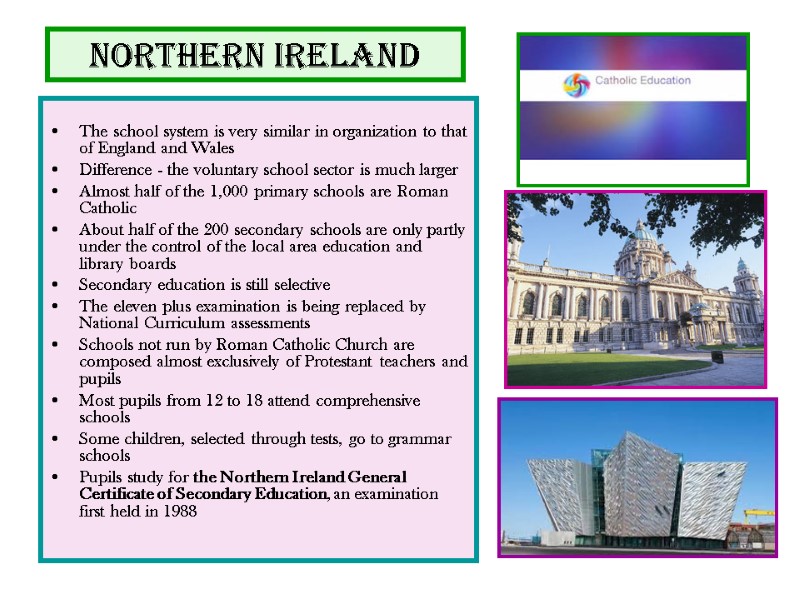
NORTHERN IRELAND The school system is very similar in organization to that of England and Wales Difference - the voluntary school sector is much larger Almost half of the 1,000 primary schools are Roman Catholic About half of the 200 secondary schools are only partly under the control of the local area education and library boards Secondary education is still selective The eleven plus examination is being replaced by National Curriculum assessments Schools not run by Roman Catholic Church are composed almost exclusively of Protestant teachers and pupils Most pupils from 12 to 18 attend comprehensive schools Some children, selected through tests, go to grammar schools Pupils study for the Northern Ireland General Certificate of Secondary Education, an examination first held in 1988
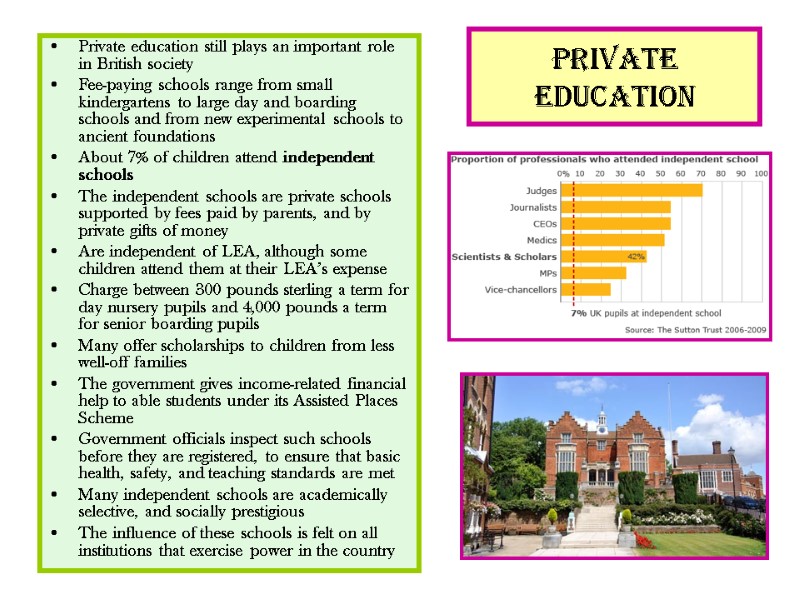
PRIVATE EDUCATION Private education still plays an important role in British society Fee-paying schools range from small kindergartens to large day and boarding schools and from new experimental schools to ancient foundations About 7% of children attend independent schools The independent schools are private schools supported by fees paid by parents, and by private gifts of money Are independent of LEA, although some children attend them at their LEA’s expense Charge between 300 pounds sterling a term for day nursery pupils and 4,000 pounds a term for senior boarding pupils Many offer scholarships to children from less well-off families The government gives income-related financial help to able students under its Assisted Places Scheme Government officials inspect such schools before they are registered, to ensure that basic health, safety, and teaching standards are met Many independent schools are academically selective, and socially prestigious The influence of these schools is felt on all institutions that exercise power in the country
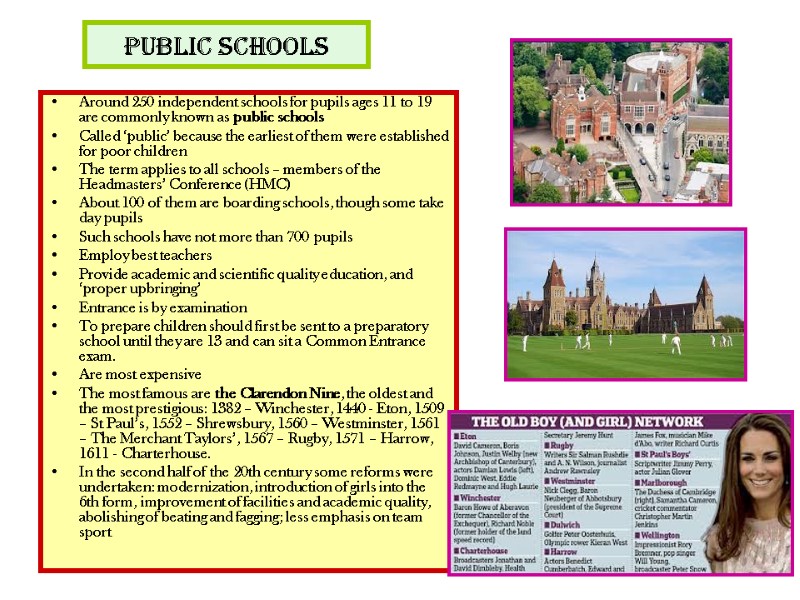
PUBLIC SCHOOLS Around 250 independent schools for pupils ages 11 to 19 are commonly known as public schools Called ‘public’ because the earliest of them were established for poor children The term applies to all schools – members of the Headmasters’ Conference (HMC) About 100 of them are boarding schools, though some take day pupils Such schools have not more than 700 pupils Employ best teachers Provide academic and scientific quality education, and ‘proper upbringing’ Entrance is by examination To prepare children should first be sent to a preparatory school until they are 13 and can sit a Common Entrance exam. Are most expensive The most famous are the Clarendon Nine, the oldest and the most prestigious: 1382 – Winchester, 1440 - Eton, 1509 – St Paul’s, 1552 – Shrewsbury, 1560 – Westminster, 1561 – The Merchant Taylors’, 1567 – Rugby, 1571 – Harrow, 1611 - Charterhouse. In the second half of the 20th century some reforms were undertaken: modernization, introduction of girls into the 6th form, improvement of facilities and academic quality, abolishing of beating and fagging; less emphasis on team sport
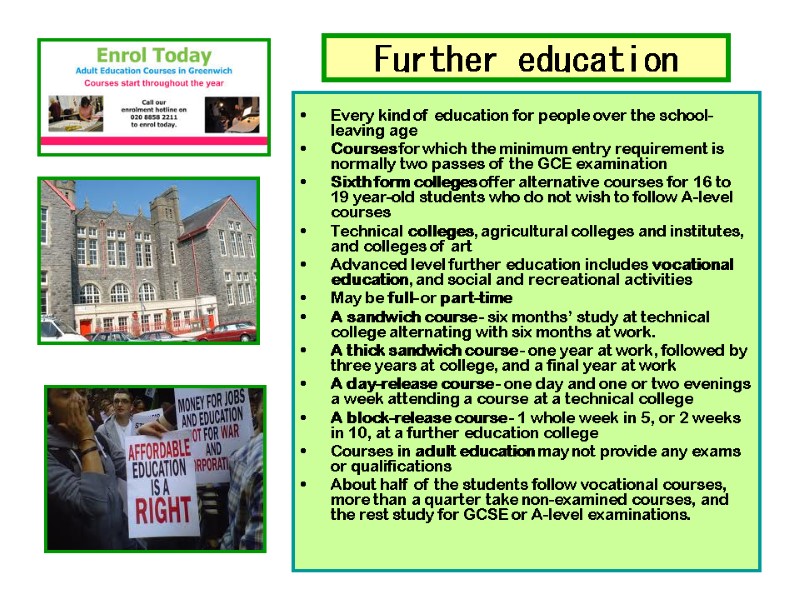
Further education Every kind of education for people over the school-leaving age Courses for which the minimum entry requirement is normally two passes of the GCE examination Sixth form colleges offer alternative courses for 16 to 19 year-old students who do not wish to follow A-level courses Technical colleges, agricultural colleges and institutes, and colleges of art Advanced level further education includes vocational education, and social and recreational activities May be full- or part-time A sandwich course - six months’ study at technical college alternating with six months at work. A thick sandwich course - one year at work, followed by three years at college, and a final year at work A day-release course - one day and one or two evenings a week attending a course at a technical college A block-release course - 1 whole week in 5, or 2 weeks in 10, at a further education college Courses in adult education may not provide any exams or qualifications About half of the students follow vocational courses, more than a quarter take non-examined courses, and the rest study for GCSE or A-level examinations.
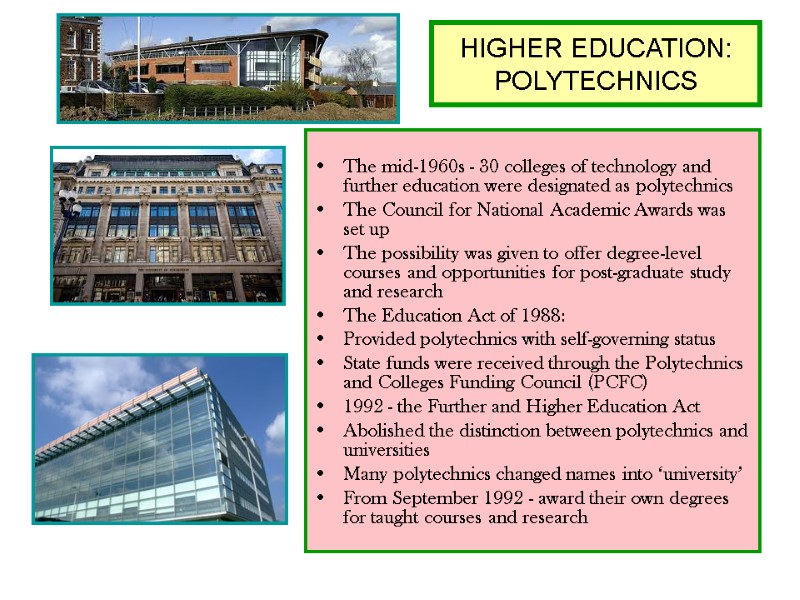
HIGHER EDUCATION: POLYTECHNICS The mid-1960s - 30 colleges of technology and further education were designated as polytechnics The Council for National Academic Awards was set up The possibility was given to offer degree-level courses and opportunities for post-graduate study and research The Education Act of 1988: Provided polytechnics with self-governing status State funds were received through the Polytechnics and Colleges Funding Council (PCFC) 1992 - the Further and Higher Education Act Abolished the distinction between polytechnics and universities Many polytechnics changed names into ‘university’ From September 1992 - award their own degrees for taught courses and research
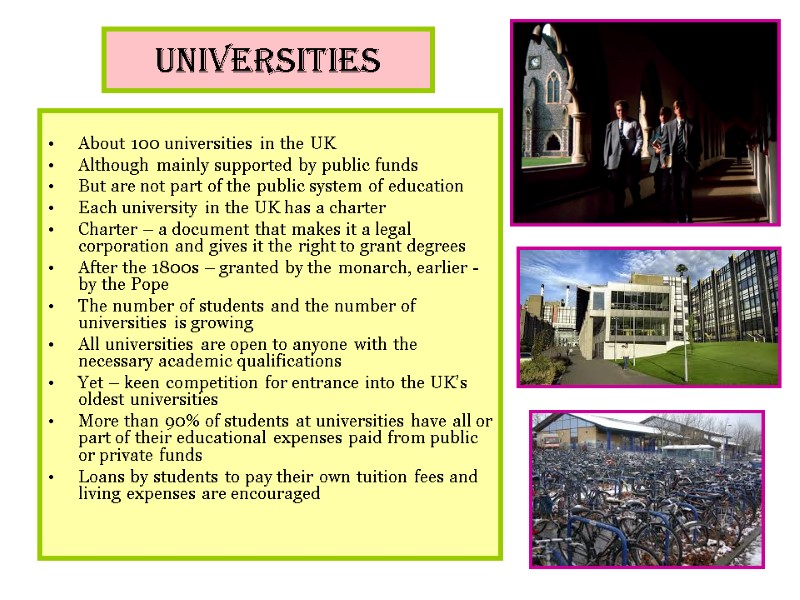
UNIVERSITIES About 100 universities in the UK Although mainly supported by public funds But are not part of the public system of education Each university in the UK has a charter Charter – a document that makes it a legal corporation and gives it the right to grant degrees After the 1800s – granted by the monarch, earlier - by the Pope The number of students and the number of universities is growing All universities are open to anyone with the necessary academic qualifications Yet – keen competition for entrance into the UK’s oldest universities More than 90% of students at universities have all or part of their educational expenses paid from public or private funds Loans by students to pay their own tuition fees and living expenses are encouraged
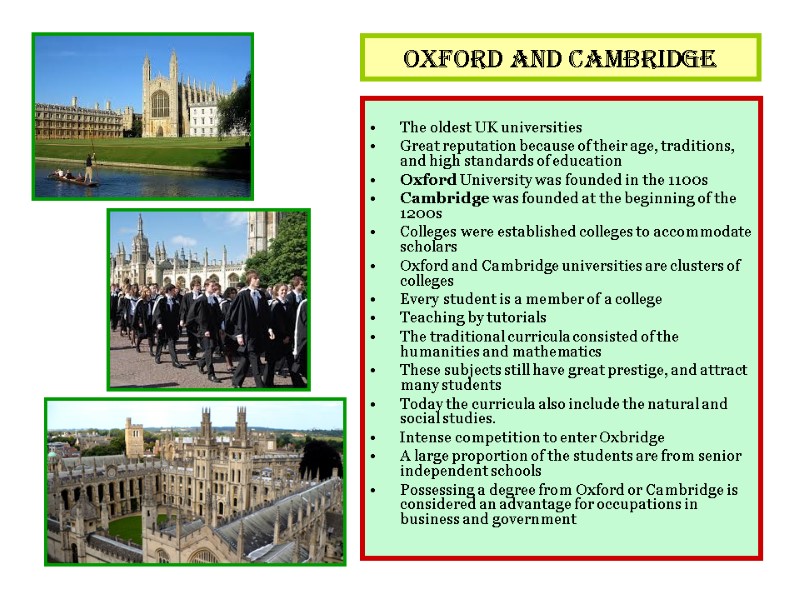
Oxford and Cambridge The oldest UK universities Great reputation because of their age, traditions, and high standards of education Oxford University was founded in the 1100s Cambridge was founded at the beginning of the 1200s Colleges were established colleges to accommodate scholars Oxford and Cambridge universities are clusters of colleges Every student is a member of a college Teaching by tutorials The traditional curricula consisted of the humanities and mathematics These subjects still have great prestige, and attract many students Today the curricula also include the natural and social studies. Intense competition to enter Oxbridge A large proportion of the students are from senior independent schools Possessing a degree from Oxford or Cambridge is considered an advantage for occupations in business and government
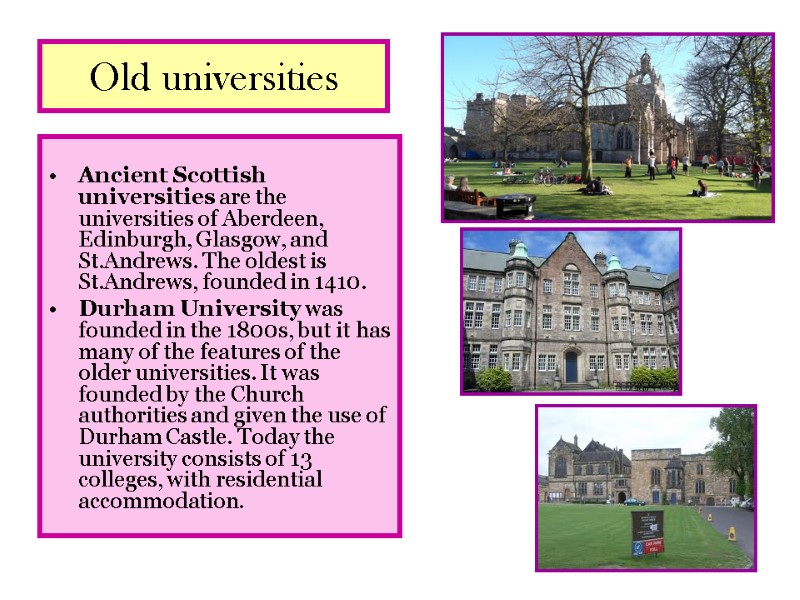
Old universities Ancient Scottish universities are the universities of Aberdeen, Edinburgh, Glasgow, and St.Andrews. The oldest is St.Andrews, founded in 1410. Durham University was founded in the 1800s, but it has many of the features of the older universities. It was founded by the Church authorities and given the use of Durham Castle. Today the university consists of 13 colleges, with residential accommodation.
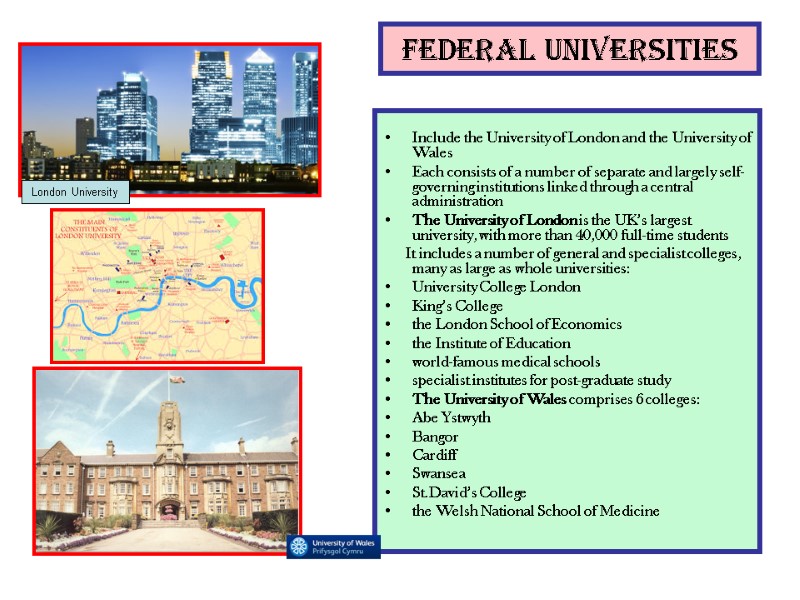
Federal universities Include the University of London and the University of Wales Each consists of a number of separate and largely self-governing institutions linked through a central administration The University of London is the UK’s largest university, with more than 40,000 full-time students It includes a number of general and specialist colleges, many as large as whole universities: University College London King’s College the London School of Economics the Institute of Education world-famous medical schools specialist institutes for post-graduate study The University of Wales comprises 6 colleges: Abe Ystwyth Bangor Cardiff Swansea St.David’s College the Welsh National School of Medicine London University
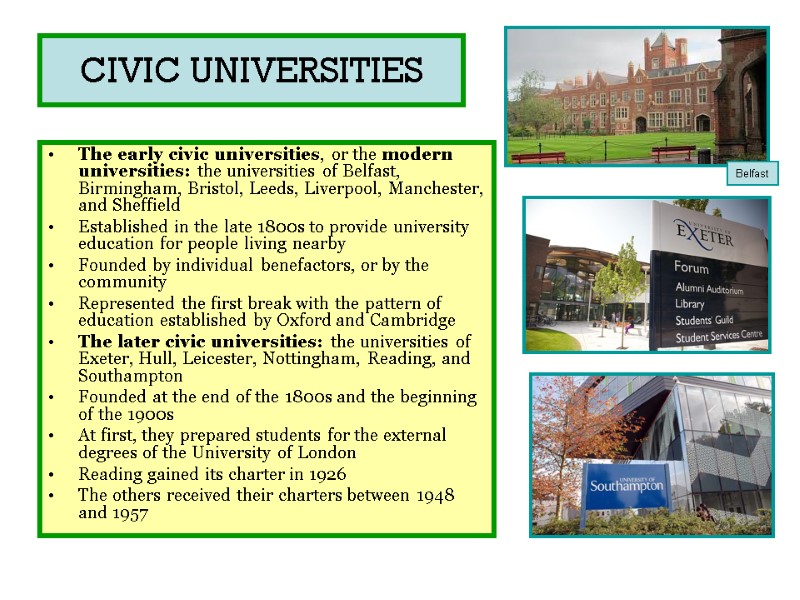
CIVIC UNIVERSITIES The early civic universities, or the modern universities: the universities of Belfast, Birmingham, Bristol, Leeds, Liverpool, Manchester, and Sheffield Established in the late 1800s to provide university education for people living nearby Founded by individual benefactors, or by the community Represented the first break with the pattern of education established by Oxford and Cambridge The later civic universities: the universities of Exeter, Hull, Leicester, Nottingham, Reading, and Southampton Founded at the end of the 1800s and the beginning of the 1900s At first, they prepared students for the external degrees of the University of London Reading gained its charter in 1926 The others received their charters between 1948 and 1957 Belfast
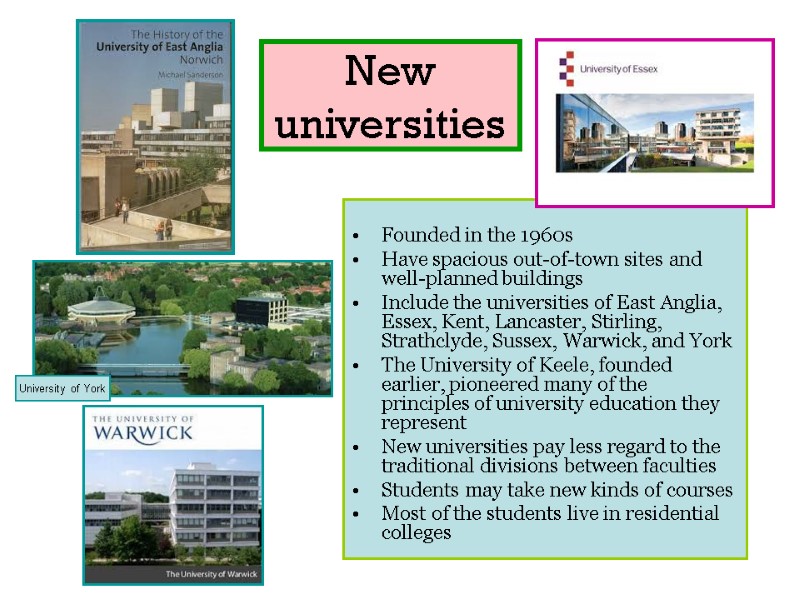
New universities Founded in the 1960s Have spacious out-of-town sites and well-planned buildings Include the universities of East Anglia, Essex, Kent, Lancaster, Stirling, Strathclyde, Sussex, Warwick, and York The University of Keele, founded earlier, pioneered many of the principles of university education they represent New universities pay less regard to the traditional divisions between faculties Students may take new kinds of courses Most of the students live in residential colleges University of York
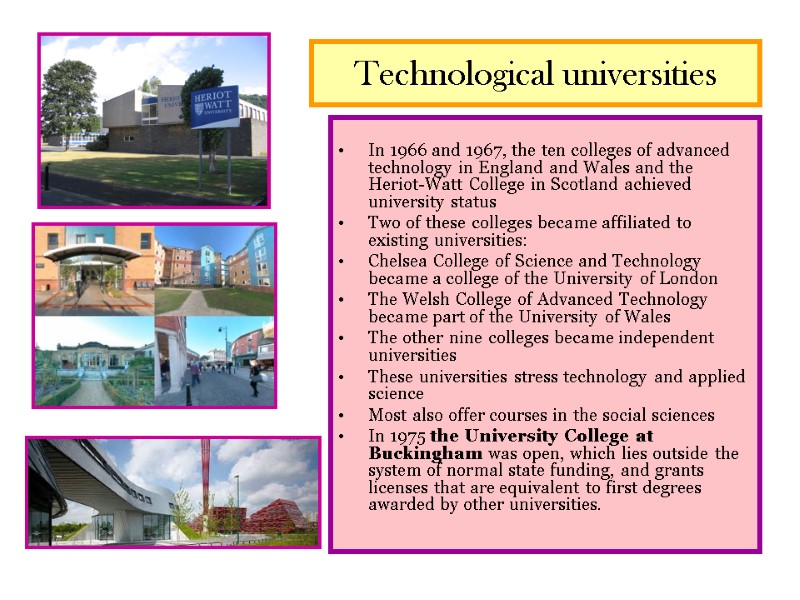
Technological universities In 1966 and 1967, the ten colleges of advanced technology in England and Wales and the Heriot-Watt College in Scotland achieved university status Two of these colleges became affiliated to existing universities: Chelsea College of Science and Technology became a college of the University of London The Welsh College of Advanced Technology became part of the University of Wales The other nine colleges became independent universities These universities stress technology and applied science Most also offer courses in the social sciences In 1975 the University College at Buckingham was open, which lies outside the system of normal state funding, and grants licenses that are equivalent to first degrees awarded by other universities.
9698-powerpoint_the_system_of_education.ppt
- Количество слайдов: 21

